Marketing Mix
Definition
The marketing mix is the set of marketing activities that a firm may use to pursue its marketing objectives for the target market.
Description
Companies need different tools to promote their product in the target market. The 4Ps makes a marketing mix- product, price, place, and promotion. These Ps now extend to include Packaging, Positioning, People and even Politics.
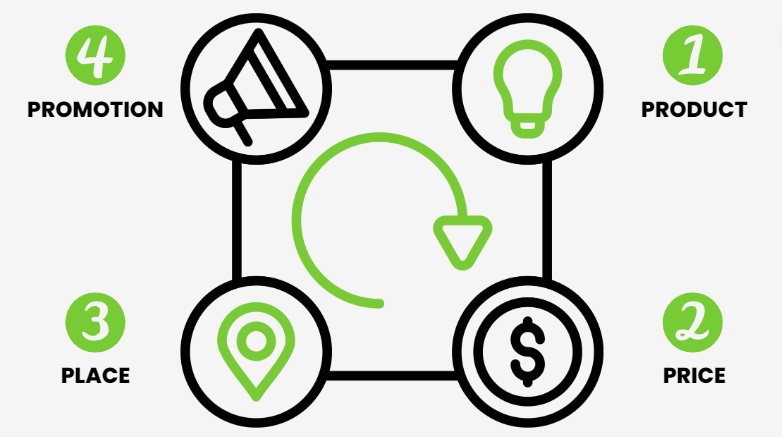
The marketing mix, also known as the 4Ps of marketing, refers to the set of marketing tactics that a company uses to promote its products or services to its target audience. The 4Ps include:
- Product: The product refers to the goods or services that a company offers to its customers. This includes the product’s features, design, packaging, and branding.
- Price: Price refers to the amount a customer pays for the product or service. Pricing strategies may include discounts, promotions, or bundling.
- Place: Place refers to the distribution channels used to make the product or service available to customers. This includes the physical location of stores, online platforms, or other media.
- Promotion: Promotion refers to the communication tactics used to promote the product or service to the target audience. This may include advertising, sales promotions, public relations, and personal selling.
Importance of Marketing Mix
The marketing mix is essential for several reasons:
- Strategic planning: The marketing mix helps businesses to plan and develop a comprehensive marketing strategy. By considering all the marketing mix elements, businesses can create a cohesive plan that aligns with their overall business objectives.
- Target audience: The marketing mix helps businesses to understand and target their audience effectively. By considering factors such as product features, pricing, distribution channels, and promotion tactics, businesses can create a marketing mix that appeals to their target audience.
- Competitive advantage: The marketing mix helps businesses to differentiate themselves from their competitors. Businesses can gain a competitive advantage by creating a unique product, pricing it competitively, making it available through preferred channels, and promoting it effectively.
- Customer satisfaction: The marketing mix helps businesses meet their customers’ needs and expectations. By creating a high-quality product, pricing it fairly, making it readily available, and promoting it effectively, businesses can create a positive customer experience that leads to repeat business and referrals.
- Measurable results: The marketing mix helps businesses measure their marketing efforts’ effectiveness. By tracking metrics such as sales, customer feedback, and engagement, businesses can evaluate the success of their marketing mix and make adjustments as needed.
How to make a marketing mix for a brand?
To create a marketing mix for a brand, you must focus on four main elements: Product, Price, Promotion, and Place (also known as the “4Ps of Marketing”).
Here’s a step-by-step guide on how to create a marketing mix for a brand:
- Product: Define your product or service and its features, benefits, and unique selling proposition. Consider what sets your brand apart from competitors and identify your target audience.
- Price: Determine the pricing strategy for your product or service. Consider factors such as production costs, competition, and perceived value. Decide whether to use a premium pricing strategy, a discount pricing strategy, or a cost-plus pricing strategy.
- Promotion: Develop a marketing plan to promote your product or service to your target audience. Consider advertising, public relations, social media, content marketing, or other marketing channels. Determine your messaging and create a marketing campaign consistent with your brand’s voice and values.
- Place: Decide on the distribution strategy for your product or service. Consider where your target audience will most likely purchase your product or service and what channels you should use to reach them. You might sell directly to customers through a website or retail store, or use intermediaries such as wholesalers or distributors.
Future strategy of marketing mix for brands
The marketing mix strategy has evolved over the years, and its future will continue to be shaped by technological advancements, changing consumer behaviour, and new marketing channels.
Here are some trends that could impact the end of the marketing mix strategy:
- Personalization: As technology enables companies to collect more customer data, personalization will become increasingly important. Brands that can tailor their products, pricing, promotion, and distribution to individual customers’ needs and preferences will have a competitive advantage.
- Digitalization: With the rise of e-commerce and social media, digital marketing channels will continue to be essential to the marketing mix. Brands must adapt their marketing strategies to leverage these channels effectively and engage with customers across multiple touchpoints.
- Sustainability: Consumers increasingly demand environmentally and socially responsible products and services. Brands that incorporate sustainability into their marketing mix strategy will be able to attract and retain customers who prioritise these values.
- Integration: The marketing mix elements of product, price, promotion, and place are becoming more interconnected. Brands that create a seamless experience across these elements will deliver a cohesive message and provide a better customer experience.
How does Marketing mix help your business?
A marketing mix is crucial for businesses to develop a successful marketing strategy. It helps businesses to:
- Develop products and services that meet customer needs:
By considering product features, pricing, promotion, and distribution, businesses can develop products and services that are relevant, desirable, and accessible to their target audience.
- Increase customer satisfaction and loyalty:
By delivering a consistent and cohesive marketing message across all elements of the marketing mix, businesses can build trust with customers, increase customer satisfaction, and foster loyalty.
- Stay competitive
Businesses can stay competitive in a constantly evolving marketplace by continuously evaluating and adjusting their marketing mix. They can respond to changes in customer needs, competitive pressures, and technological advancements to maintain their market position.
- Achieve business objectives
By aligning the marketing mix with business objectives, businesses can increase sales, market share, and profitability. They can also measure the effectiveness of their marketing efforts and make data-driven decisions to optimise their marketing mix.
Example
Nykaa is a popular Indian e-commerce company that sells a wide range of beauty and wellness products. Here’s how Nykaa uses the four elements of the marketing mix:
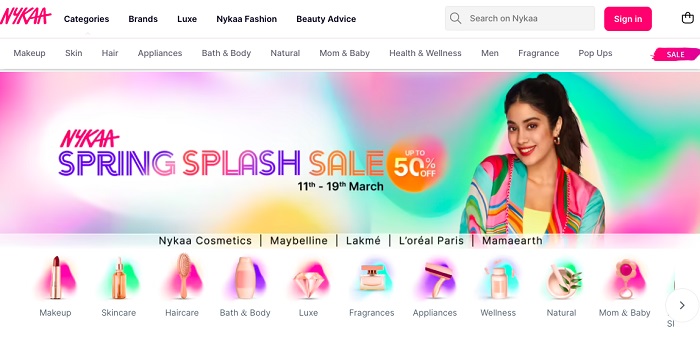
1. Product:
Nykaa offers various beauty and wellness products from various brands, including makeup, skincare, haircare, fragrances, and personal care.
Nykaa also has its own brand of beauty products, Nykaa Cosmetics, which offers high-quality makeup and skincare products.
The company regularly introduces new products and collaborations to keep up with the latest trends and customer demands.
2. Price:
Nykaa’s pricing strategy aims to provide value to customers while maintaining profitability.
The company offers products at various prices, from affordable to premium, to cater to different customer segments.
Nykaa also provides discounts, offers, and loyalty programs to incentivize customers to purchase from their platform.
3. Promotion:
Nykaa uses various marketing channels to reach its target audience, including television, digital, and social media.
The company’s marketing campaigns promote new product launches, seasonal collections, and discounts.
Nykaa also collaborates with influencers and celebrities to promote its products and create buzz on social media.
4. Place
Nykaa operates primarily as an e-commerce company, selling products through its website and mobile app.
The company also has a few brick-and-mortar stores across major cities in India, providing customers with an omnichannel shopping experience.
Nykaa also offers fast and reliable delivery services to ensure customer satisfaction.
Marketing Key Performance Indicators (KPIs)
Definition
A marketing KPIs also known as Key Performance Indicators is a measurable value that tracks the performance of marketing activities and campaigns against predetermined goals and objectives.
Description
Measuring and evaluating performance is important because only then can you make some improvement in business.
KPIs help businesses and marketers understand how effective their marketing efforts are in achieving their desired outcomes.
Examples of marketing KPIs include website traffic, conversion rates, lead generation, customer acquisition cost, customer lifetime value, social media engagement, email open and click-through rates, and many others.
These KPIs can be specific to different channels and campaigns and should be chosen based on the objectives of the marketing plan.
By monitoring marketing KPIs, businesses can identify areas of success and areas that need improvement.
This data can then be used to adjust marketing strategies and tactics to maximise marketing efforts’ return on investment (ROI).
How to Use Key Performance Indicators?
Here are some steps to help you effectively use key performance indicators (KPIs):
- Define your business objectives: KPIs should be aligned with your overall business objectives. Start by identifying the goals and objectives that are most important to your business.
- Choose relevant KPIs: Once you have identified your business objectives, choose KPIs that are relevant to those objectives. Look for KPIs that will help you track progress toward your goals and make data-driven decisions.
- Set targets: Establish targets for your KPIs based on your business objectives. These targets should be specific, measurable, achievable, relevant, and time-bound (SMART).
- Track your KPIs: Use a dashboard or reporting tool to track your KPIs over time. This will help you monitor progress toward your targets and identify improvement areas.
- Analyze your data: Regularly analyze your KPI data to identify trends, patterns, and areas for improvement. Look for insights that can help you make data-driven decisions.
- Take action: Based on your analysis, improve your KPI performance. This could involve adjusting your marketing strategy, changing your tactics, or investing more resources into areas that are performing well.
- Review and refine: Regularly review your KPIs and refine them as needed. As your business goals and objectives change, your KPIs may need to be updated to reflect those changes.
Future Strategies for Marketing KPI
As businesses continue to evolve and adapt to changes in the market and technology, the future of KPIs will also change. Here are some potential future strategies for KPIs:
- Greater focus on customer experience: As businesses increasingly focus on delivering exceptional customer experiences, KPIs must shift to reflect this focus. Customer satisfaction, lifetime value, and net promoter score may become even more critical.
- Integration with AI and machine learning: As AI and machine learning continue to advance, businesses may be able to use these technologies to improve their KPI tracking and analysis. This could involve using machine learning algorithms to identify patterns in data and make predictions about future performance.
- Real-time monitoring: KPIs may become more common as businesses seek to be more responsive and agile. This could involve using sensors and other IoT devices to gather real-time data and feed it into dashboards and reporting tools.
- Emphasis on sustainability and social responsibility: KPIs that measure sustainability and social responsibility may become more critical as businesses increasingly prioritise these issues. KPIs such as carbon emissions, waste reduction, and community impact may become more common.
- Integration with blockchain technology: Blockchain technology may improve the accuracy and security of KPI data. By using blockchain to track data, businesses may improve transparency and reduce the risk of fraud.
Benefits of Marketing KPIs
There are many benefits of using marketing key performance indicators (KPIs), including:
- Focus on essential metrics: KPIs help businesses focus on the most critical metrics that drive business success. By tracking and analysing KPIs, companies can make data-driven decisions and optimise their marketing efforts to achieve better results.
- Identify areas for improvement: By tracking KPIs, businesses can identify areas that need improvement and adjust their marketing strategies accordingly. This can help companies to stay competitive and adapt to changes in the market.
- Measure ROI: KPIs help businesses measure their marketing efforts’ return on investment (ROI). By analysing KPI data, businesses can determine which marketing campaigns and channels are most effective and allocate resources accordingly.
- Increase accountability: KPIs help increase accountability across the organisation. By setting clear KPI targets, everyone in the organisation knows what is expected of them and can work together towards common goals.
- Improve communication: KPIs help improve communication between different teams and departments. By tracking KPIs, everyone in the organisation has access to the same data and can make informed decisions based on that data.
- Align marketing efforts with business objectives: KPIs help businesses align their marketing efforts with their overall business objectives. By choosing KPIs that are relevant to their business goals, businesses can ensure that their marketing efforts are focused and effective.
Example
One example of an Indian brand that has successfully used marketing key performance indicators (KPIs) is OYO Rooms.
OYO Rooms is a hospitality company that offers budget hotel rooms to travellers in India and other countries.
OYO Rooms has used KPIs to track its growth and success. In particular, the company has focused on KPIs related to customer acquisition, revenue growth, and customer satisfaction.
One critical KPI that OYO Rooms tracks are its net promoter score (NPS), which measures customer satisfaction and loyalty.
OYO Rooms has set a target NPS score and uses customer feedback to continuously improve its services and increase customer satisfaction.
OYO Rooms also tracks KPIs related to revenue growth, such as revenue per available room (RevPAR) and occupancy rates.
The company can adjust its pricing and marketing strategies to increase revenue and profitability by monitoring these KPIs.
Finally, OYO Rooms tracks KPIs related to customer acquisition, such as the cost of customer acquisition (CAC) and the lifetime value of a customer (LTV).
By analysing these KPIs, the company can optimise its marketing efforts and focus on acquiring customers most likely to become loyal and profitable over time.
Overall, OYO Rooms’ success is partly attributed to its focus on marketing KPIs. By using KPIs to track its performance and adjust its strategies, the company has achieved rapid growth and become a leading player in the hospitality industry in India and beyond.
FAQ
What are marketing KPIs?
Marketing KPIs are metrics used to track and measure the performance of marketing campaigns, activities, and channels. They are used to evaluate the effectiveness of marketing strategies and tactics and make data-driven decisions to optimise marketing efforts.
What are some common marketing KPIs?
Common marketing KPIs include website traffic, conversion rate, cost per lead, customer lifetime value, customer acquisition cost, net promoter score, revenue growth, and return on investment.
How do you select the proper marketing KPIs for your business?
To select the proper marketing KPIs for your business, you need to identify your business goals and objectives and then choose relevant KPIs.
You should also consider the specific marketing channels and tactics and select the KPIs most appropriate for measuring performance in those areas.
How do you measure marketing KPIs?
Marketing KPIs can be measured using various tools and techniques, such as web analytics software, marketing automation platforms, customer surveys, and financial reports.
The specific methods will depend on the KPIs being tracked and the available data sources.
What are the benefits of using marketing KPIs?
The benefits of using marketing KPIs include better decision-making, improved performance tracking, increased accountability, enhanced communication, and alignment of marketing efforts with business objectives.
How do you use marketing KPIs to optimise marketing efforts?
To use marketing KPIs to optimise marketing efforts, you need to regularly monitor and analyse KPI data, identify areas for improvement, and make data-driven decisions to adjust marketing strategies and tactics.
Businesses can improve performance and achieve better results by continually optimising marketing efforts based on KPI data.
What are the 5 KPIs for a brand?
The five KPIs for a brand can vary depending on the industry and specific business goals, but here are five common KPIs that many brands track:
- Brand awareness: This KPI measures how well-known a brand is among its target audience. It can be tracked using metrics such as social media mentions, website traffic, and search engine rankings.
- Customer engagement: This KPI measures how engaged customers are with a brand. It can be tracked using metrics such as social media likes, comments, and shares and email open and click-through rates.
- Customer loyalty: This KPI measures how loyal customers are to a brand. It can be tracked using metrics such as repeat purchases, customer retention rates, and net promoter score (NPS).
- Brand equity: This KPI measures the value of a brand in the eyes of customers and the market. It can be tracked using metrics such as brand reputation, brand recognition, and brand associations.
- Marketing ROI: This KPI measures marketing efforts’ return on investment (ROI). It can be tracked using metrics such as cost per lead, customer acquisition cost (CAC), and customer lifetime value (CLV).
Marketing Funnel
Definition
A marketing funnel is a model businesses use to visualise the journey a potential customer goes through to become a paying customer.
Description
The funnel metaphorically represents the process, starting with a wide opening at the top and gradually narrowing down towards the bottom. The marketing funnel typically has four stages:
- Awareness: At the top of the funnel, potential customers become aware of a brand or product through advertising, social media, word-of-mouth, or other marketing channels.
- Interest: In this stage, potential customers show interest in the product or service by visiting the website, signing up for a newsletter, or engaging with the brand on social media.
- Decision: Here, potential customers are considering whether or not to make a purchase. They may read reviews, compare prices, or ask for recommendations from friends and family.
- Action: At the bottom of the funnel, the potential customer purchases and becomes a paying customer.
A valuable tool for businesses because it provides a framework for understanding potential customers’ journey when making a purchase decision.
By breaking down this journey into stages, businesses can create targeted marketing strategies to move customers through the funnel and convert them into paying customers.
Importance of Marketing Funnel
The marketing funnel is important for businesses for several reasons:
- Helps understand customer behaviour: The marketing funnel provides a framework for understanding the customer journey, from initial awareness to final purchase decisions. This understanding helps businesses tailor their marketing strategies to the needs and preferences of their potential customers.
- Improves targeting: By understanding the different stages of the funnel, businesses can target their marketing efforts more effectively, reaching potential customers at the right time and with the right message.
- Increases conversion rates: By guiding potential customers through each stage of the funnel, businesses can increase the likelihood that they will make a purchase. This can lead to higher conversion rates and increased revenue.
- Improves customer retention: The marketing funnel continues after the purchase decision. By continuing to engage with customers after the sale, businesses can increase customer loyalty and encourage repeat purchases.
How to create a marketing funnel for a brand?
Here are the steps to create a marketing funnel for a brand:
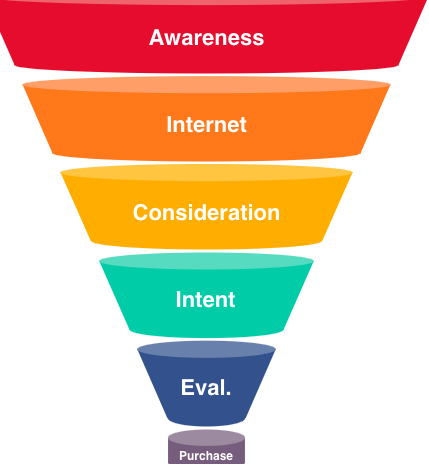
- Define your target audience: Identify your ideal customer persona, including demographic information, preferences, and pain points.
- Create awareness: Develop a strategy to raise brand awareness using social media, paid advertising, content marketing, and other channels. The goal is to attract potential customers to your brand and generate interest.
- Nurture leads: Once you have attracted potential customers, engage with them through email marketing, retargeting ads, and other tactics to keep your brand top-of-mind and build a relationship.
- Encourage decision-making: Use social proof, testimonials, reviews, and other tactics to persuade potential customers to purchase.
- Close the sale: Make purchasing easy for potential customers with clear calls to action, simple checkout processes, and responsive customer support.
- Foster loyalty: Continue to engage with your customers after the sale with email marketing, loyalty programs, and other tactics to encourage repeat purchases and referrals.
- Measure and optimise: Use analytics tools to track your marketing funnel metrics, including traffic, conversions, and revenue, and continually optimise your strategy based on what’s working best.
Future Strategies to Create Marketing Funnel
Here are a few potential future strategies to create a marketing funnel:
- Emphasise personalised content: Personalization is becoming increasingly important in marketing. Creating customised content and experiences for potential customers will likely be vital to any marketing funnel strategy.
- Leverage emerging technologies: With the rise of artificial intelligence, virtual reality, and other technologies, businesses will have new opportunities to engage with potential customers in unique and immersive ways. For example, virtual reality experiences could be used to showcase products or services, while chatbots powered by AI could provide personalised customer service.
- Prioritise social media: Social media platforms are already a crucial part of many marketing funnels and will become even more critical in the future. Brands must continue finding new and creative ways to engage with potential customers on social media while leveraging emerging platforms and features.
- Focus on sustainability and social responsibility: As consumers become increasingly concerned about sustainability and social responsibility, brands prioritising these values will have a competitive advantage. Incorporating sustainability and social responsibility into your marketing funnel strategy can help build brand loyalty and attract like-minded customers.
- Embrace omnichannel marketing: In the future, businesses must bring an omnichannel approach to the market, ensuring potential customers can engage with their brand across multiple channels and touchpoints. This may involve developing new media, such as voice assistants or messaging apps, or optimising existing channels to provide a seamless customer experience.
Example
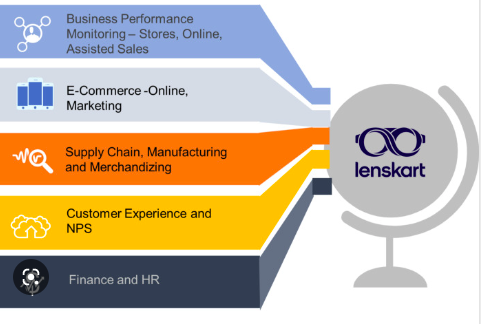
One example of an Indian brand successfully implementing a marketing funnel is Lenskart, an online eyewear retailer. Here is an overview of how Lenskart’s marketing funnel works:
- Awareness: Lenskart uses a variety of marketing channels, including TV ads, social media, and influencer marketing, to generate awareness of its brand and products.
- Interest: Once potential customers know of Lenskart, the company uses targeted ads and email marketing to keep them engaged and interested. For example, Lenskart sends personalized emails with product recommendations based on the customer’s browsing history.
- Consideration: To encourage potential customers to make a purchase, Lenskart offers a variety of discounts and promotions. They also have a virtual try-on feature, which allows customers to see how different frames will look on their faces.
- Conversion: Lenskart makes it easy for customers to purchase their products with a simple checkout process and multiple payment options. They also offer a 14-day return policy, which helps build trust with potential customers.
- Retention: After the sale, Lenskart continues to engage with customers through personalised emails, special offers, and a loyalty program. This helps encourage repeat purchases and builds brand loyalty.
FAQs
What is a marketing funnel?
A marketing funnel is a model that represents the customer journey from the initial awareness of a product or service to the final purchase decision.
It’s called a funnel because, just like a funnel, it narrows as customers move through the journey stages, with a decreasing number of prospects at each stage.
What are the stages of the marketing funnel?
The stages of the marketing funnel are usually defined as follows:
- Awareness: At this stage, potential customers become aware of your product or service.
- Interest: At this stage, potential customers express interest in your product or service and want to learn more about it.
- Consideration: At this stage, potential customers evaluate your product or service and compare it with other options.
- Intent: At this stage, potential customers purchase your product or service.
- Purchase: At this stage, potential customers become actual customers by purchasing.
Why is the marketing funnel important?
The marketing funnel is important because it helps businesses understand the customer journey and optimise their marketing efforts to increase sales and revenue.
By tracking the performance of each stage of the funnel, businesses can identify areas for improvement and make data-driven decisions to drive growth.
How can businesses optimise their marketing funnel?
There are several ways businesses can optimise their marketing funnel, including:
- Creating high-quality content that resonates with potential customers at each funnel stage.
- Using targeted advertising to reach potential customers at each stage of the funnel.
- Providing personalised experiences to potential customers based on their behaviour and preferences.
- Offering incentives and promotions to encourage potential customers to move through the funnel.
- Analysing data and making data-driven decisions to optimise each stage of the funnel.
Can the marketing funnel be applied to any type of business?
Yes, it can be applied to any type of business, regardless of size or industry. However, the specifics of the funnel may vary depending on the business and its target audience.
Therefore, it’s essential to tailor the marketing funnel to the specific needs and preferences of the target audience.
Marketing Communication
What Is Marketing Communication?
Marketing communication uses various tools and strategies to promote a product, service, or brand to a target audience.
Description
It is essential for businesses to inform, persuade and influence their target audience about their products or services, building brand awareness and driving sales growth.
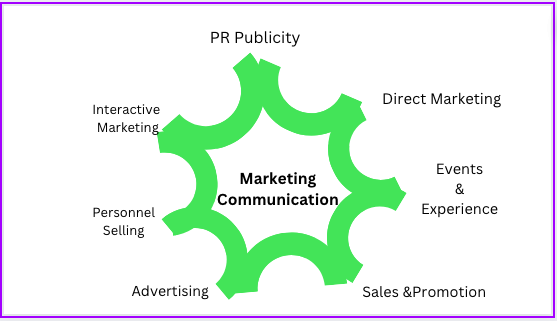
With effective marketing communication, companies may be able to reach their intended audience and take advantage of potential sales opportunities.
It involves crafting and delivering messages that aim to inform, persuade, and influence the behaviour of potential customers.
These activities include advertising, public relations, sales promotions, personal selling, direct marketing, and digital marketing.
Establishing communication is essential for building brand awareness, creating customer loyalty, and driving sales growth.
Importance of Marketing Communication
it is essential for businesses because it helps to:
- Build brand awareness and recognition: By consistently communicating a brand’s message and values through various channels, it helps to create a strong and recognizable brand image in the minds of consumers.
- Drive sales and revenue: Effective communication can persuade potential customers to take action, such as making a purchase, signing up for a service, or attending an event, ultimately leading to increased sales and revenue for the business.
How To Prepare An Effective Marketing Communication Strategy?
Here are some steps to prepare a strategy for it:
- Define your target audience: Identify your ideal customer and their needs, preferences, and behaviours.
- Establish your objectives: Determine what specific goals you want to achieve through your communication efforts, such as increasing brand awareness or driving sales growth.
- Develop your messaging: Craft a compelling message that resonates with your target audience and communicates your brand’s values, benefits, and unique selling proposition.
- Choose your channels: Decide which communication channels, such as social media, email, or advertising, will be most effective in reaching your target audience and achieving your objectives.
- Create a content plan: Develop a plan for creating and delivering content across your chosen channels, including topics, formats, and frequency.
- Determine your budget: Establish a budget for your communication activities, including paid advertising, content creation, or other expenses.
- Set metrics for measuring success: Identify key performance indicators (KPIs) for measuring the effectiveness of your efforts, such as website traffic, social media engagement, or sales conversions.
Future Strategy for Effective Marketing Communication
The future will likely be shaped by several trends and developments, including:
- Increased use of AI and automation: As technology advances, we can expect more businesses to use AI and automation to deliver personalised and targeted marketing messages at scale.
- Greater emphasis on storytelling and user-generated content: Brands increasingly turn to storytelling and user-generated content to create more authentic and engaging marketing campaigns that resonate with their audience.
- Rise of social media influencers: Influencer marketing is becoming more popular as businesses leverage social media personalities’ reach and influence to promote their products and services.
- The growing importance of data privacy and transparency: Consumers are becoming more aware of the data being collected about them and demanding greater transparency and control over their personal information.
- The continued growth of mobile and video marketing: Mobile devices and video content are increasingly dominant in the marketing landscape. Businesses must adapt to these trends to stay relevant and reach their target audience.
Benefits of Effective Marketing Communication
It plays a crucial role in the success of businesses by building brand awareness, driving sales, engaging with customers, providing insights, and enhancing credibility and reputation.
It offers several benefits to businesses, including:
- Building brand awareness: Effective communication helps create brand recognition and familiarity among target audiences, leading to increased customer loyalty and advocacy.
- Generating leads and driving sales: By promoting products or services through targeted messaging and advertising, it can drive sales growth and generate new leads for the business.
- Engaging with customers: Through social media, email, and other channels, it allows businesses to connect and engage with customers, building relationships and enhancing customer satisfaction.
- Providing valuable insights: It can provide valuable data and insights into customer behaviour, preferences, and opinions, which can inform business decisions and improve marketing strategies.
- Enhancing credibility and reputation: It can help to establish a business as a credible and reputable authority in its industry, building trust and confidence among customers and stakeholders.
Example of Marketing Communication
One example of effective marketing communication is Nike’s “Just Do It” campaign. The campaign was launched in 1988 and has since become one of history’s most successful and iconic marketing campaigns.

The “Just Do It” slogan is simple, memorable, and resonates with Nike’s target audience of athletes and fitness enthusiasts.
In addition, the campaign has featured various celebrity endorsements, including Michael Jordan, Serena Williams, and Colin Kaepernick, further reinforcing Nike’s position as a brand that champions individuality, athleticism, and social justice.
Nike has also leveraged various marketing channels, including television, print, and social media, to spread the “Just Do It” message and showcase its products.
The brand has used storytelling, emotional appeal, and humour to connect with consumers and create a strong emotional bond.
Overall, Nike’s “Just Do It” campaign is an excellent example of effective marketing communication, demonstrating how a powerful message, targeted messaging, and a multi-channel approach can create a lasting and impactful brand.
FAQs
What is marketing communication?
It refers to businesses’ various tools and tactics to communicate messages about their products or services to target audiences.
These include advertising, public relations, sales promotions, direct marketing, and personal selling.
Why is marketing communication important?
It is essential because it helps businesses to build brand awareness, engage with customers and potential customers, differentiate themselves from competitors, and ultimately drive sales and revenue.
What are some common marketing communication channels?
Some common channels include television and radio advertising, print advertising, online advertising, social media marketing, email marketing, content marketing, and public relations activities such as press releases and media outreach.
What is a marketing communication strategy?
It is a plan that outlines how a business will use various communication channels to achieve its marketing goals.
It includes identifying target audiences, developing key messages, selecting appropriate communication channels, and measuring the strategy’s effectiveness.
How do you measure the effectiveness of a marketing communication campaign?
The effectiveness of a campaign can be measured in various ways, such as reach and engagement metrics, sales data, website traffic, social media metrics, and customer feedback or surveys.
What are some challenges of marketing communication?
Some challenges include identifying the most effective channels for reaching target audiences, creating compelling and engaging messages, managing budgets effectively, and staying ahead of rapidly changing technologies and consumer behaviours.
What are some best practices for effective marketing communication?
Some best practices for this include understanding your target audience, being consistent in your messaging across all channels, using data and analytics to inform your strategies, staying current with new technologies and trends, and continually testing and refining your approach based on results.
Market Share
Definition
The percentage of a market’s total sales that is earned by a particular company over a period of time is termed as market share.
Description
Identifying the total share of sales a company makes in a particular period and in a specific industry is important for a business segment. It helps to identify the prospects of growth and possibilities of improvement.
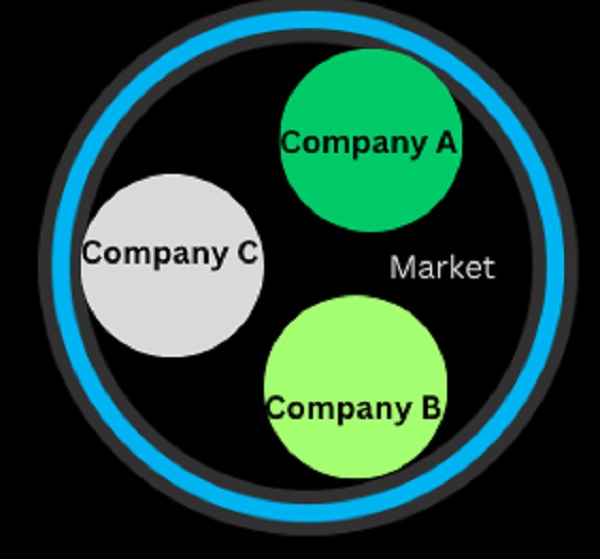
By knowing the total sales made by a company over a specified period of time, different patterns and purchase behaviour of the buyers can be observed.

The market share metric gives a general idea of the size of the company when compared to the leading players in the market.
Future Strategies To Improve Market Share
There are several strategies that a business can use to improve its market share, including:
- Product differentiation: A business can differentiate its products or services from its competitors to attract more customers. This can be achieved by offering unique features or benefits, such as better quality, better performance, or lower prices.
- Marketing and advertising: A business can increase its market share by investing in marketing and advertising campaigns that target its desired customer segments. This can increase brand awareness and generate more leads.
- Pricing strategy: A business can use pricing strategies to improve its market share. For example, it could offer discounts or special promotions to attract more customers or implement dynamic pricing strategies that adjust prices based on demand.
- Expand distribution channels: A business can reach more customers and increase its market share by expanding its distribution channels. This can be achieved by partnering with other businesses, opening new stores or locations, or selling through online marketplaces.
- Improve customer experience: A business can improve its market share by providing a superior customer experience. This can be achieved by offering excellent customer service, improving product quality, and providing a seamless shopping experience across all channels.
- Acquire competitors: Another strategy to increase market share is to acquire competitors. This can eliminate competition and gain access to their customer base, products, and expertise. However, this strategy can also be risky and expensive.
How is market share used by the companies?
Market share is used by companies for several purposes, including:
- Competitor analysis: Market share information is used by companies to analyse their competitors. By understanding their competitors’ market share, companies can identify areas of opportunity and potential threats to their business.
- Sales forecasting: Market share data is used by companies to forecast sales and revenue. By tracking their market share over time, companies can project how their sales and revenue will grow or decline.
- Pricing strategy: Market share information is used by companies to develop pricing strategies. For example, companies may adjust their prices based on their market share to maintain profitability and competitiveness.
- Product development: Market share information is used by companies to guide product development efforts. By understanding which products or services are performing well in the market, companies can focus their resources on developing or improving new products.
- Marketing and advertising: Market share data is used by companies to inform their marketing and advertising campaigns. Companies can increase their market share and revenue by targeting customer segments not currently using their products or services.
- Investment decisions: Market share data is used by investors to make investment decisions. By analysing a company’s market share, investors can assess the company’s growth potential and overall performance in the market.
Benefits of Knowing the Market Share
Knowing your market share can provide several benefits, including:
- Understanding your competitiveness: Knowing your market share helps you understand how well your business competes in the marketplace. It indicates how well your products or services perform compared to your competitors.
- Identifying growth opportunities: If you have a low market share, it indicates room for growth. By identifying the areas where you have a lower market share, you can focus on those areas to capture more market share and increase your sales.
- Benchmarking against competitors: By knowing your market share, you can benchmark your business against your competitors. This allows you to identify areas where you are outperforming them and areas where you need to improve.
- Making strategic decisions: Market share information can help you make strategic decisions about pricing, advertising, and product development. For example, if you have a high market share, you can increase prices without losing customers. Alternatively, if you have a low market share, you may need to lower costs to attract more customers.
- Improving customer satisfaction: By understanding your market share, you can better understand your customers’ needs and preferences. This can help you tailor your products and services to meet their needs, improving customer satisfaction and loyalty.
Example
According to recent market research reports, as of 2022, Samsung has a market share of around 22%, Xiaomi has a market share of about 21%, and Vivo has a market share of around 19%. Other players in the market, such as Oppo and Realme, have smaller market shares.
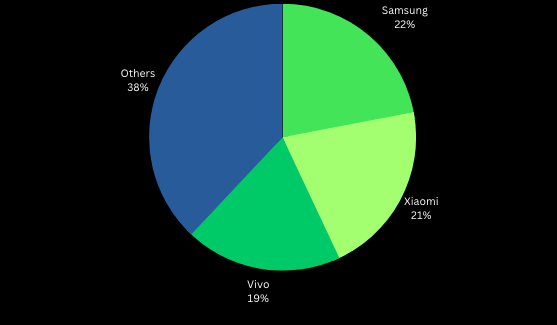
This information is essential for these companies to understand how they perform in the market compared to their competitors.
For example, if Samsung’s market share declines, it may need to adjust its pricing or marketing strategy to remain competitive.
Similarly, if Xiaomi’s market share is increasing, it may want to invest more in advertising or new product development to maintain its momentum.
This information is also important for investors, as it can help them evaluate these companies’ growth potential and profitability. Overall, understanding market share is crucial for companies in India.
FAQ
What is market share?
Market share is the percentage of a market’s total sales or revenue earned by a particular company or brand.
Why is market share significant?
Market share is substantial because it provides companies with insight into their market performance, competitive position, and growth potential. It is also a critical metric investors use to evaluate companies and make investment decisions.
How is market share calculated?
Market share is calculated by dividing a company’s total sales or revenue in a particular market by dividing it by the total sales or revenue of the entire market.
What are some ways to increase market share?
Strategies to increase market share can include product differentiation, marketing and advertising, pricing strategies, expanding distribution channels, improving customer experience, and acquiring competitors.
How can a company use market share information?
Companies can use market share information for competitor analysis, sales forecasting, pricing strategy, product development, marketing and advertising, and investment decisions.
What are some limitations of market share as a metric?
Market share does not consider profit margins, customer satisfaction, or brand loyalty. It also needs to provide information about the market size or potential for growth.
Therefore, companies should use other metrics in conjunction with market share to gain a complete picture of their performance in the market.
Inbound Marketing
What Is Inbound Marketing?
Inbound marketing is a strategic approach in creating valuable content that aligns with the needs of the target audience.
Understanding Inbound Marketing
Marketing of your product or services is important to increase awareness, make loyal customers, and earn revenue.
It is equally relevant to keep the audience informed and updated about the products and services.
One of the tested and cost-effective ways in which you can also establish a communication with your audience is inbound marketing.
The intent of inbound marketing is to attract new prospects, engage them and delight them individually.

Creating content is the most meaningful way in which you can interact with your target audience and inspire them for a long-term relationship. Inbound marketing methodology revolves around:
Attract:
It implies that you can attract your audience with meaningful content. The content should build the trust in the readers who willfully come back and read your content.
You can create content such as blogs, content on social media, and other posts that offer value to the readers. It is wise to include “How To Guides” and Customer testimonials to increase credibility and trust in your content.
For a deeper level of inbound marketing, optimise the content on SEO strategy. After SEO optimisation, the chances of your content appearing organically on Google will increase.
Engage:
Craft and engaging content that touches the pain points of the readers. It will be a plus to engage the audience so that they buy from you.
Establish customer relationship management to offer solutions to the customers.
Talk to them more about how the product and service will help them instead of just talking about the products.
Delight:
Empower your customers so that they make the purchase easily. Well-times chatbots and feedback from customers is a mindful way to delight the customers.
You can send a feedback form and know their views about your product. Ensure that you add some responses on social media accounts also.
It delights the customers and makes them confident when they make a purchase from your brand.
Example
Through above mentioned inbound marketing definition we have understood what it is, now lets understand example of inbound marketing, Cheetos brought up a remarkable social media campaign. The brand was planning to launch a new snack product-Cheetos Crunch Pop Mix.
They thought that a Super Bowl Sunday commercial just wouldn’t do. The Cheetos marketing team used Snapchat AR.
It allowed the Snapchat users to point their camera at Cheetos TV commercials and grab a bag off the screen. The people who used this, they received a coupon for one free bag of Crunch Pop Mix.

The result of the commercial was that about 50,000 bags were stolen and traffic to Cheetos site increased by 2500%.
This act of inbound marketing became a success, because it could blend the digital experience with the real world. The AR visual was aired for a limited duration but the free snack was real.
Importance of Inbound Marketing
74% of the marketers think that it is a primary approach to marketing. 40% marketers say that content is important to their marketing strategy. 70% of people prefer content over advertising. (Source: Analytico)
- Long-term marketing strategy:
It is a long-term marketing strategy. It is sustainable and hence it takes a little longer to build an inbound strategy. Planning email and other social media content takes time.
Apart from organising content, it is also important to select which channel you should reach the right audience.
- Generate quality leads:
It assists you to generate leads through the content you post on social media. The content can generate leads with high potential to convert. Inbound marketing allows you to create personalised content and reach your target audience.
- Lead nurturing:
After you know the people who are interested in your content and what they would like to read, it gets easier for you to engage them in meaningful content. You can send them content that increases their awareness and builds their trust.
- Cost-efficient:
Marketing is all about shelling money to reach your target. In this course, inbound marketing is a cost-efficient way as it gives you lead and an opportunity to convert it through content.
- Increases visibility on SERP:
Creating SEO optimised content will help increase visibility of your brand on Google’s result. Hence, optimise the articles for high ranking keywords and improve your ranking in Google. It helps you stay ahead of the competitors.
- Build trust and credibility:
When you consistently produce quality content for your audience, you delight your customers. It helps these customers build trust in your brand. Alongside, it encourages them to gain new customers.
Inbound Marketing Strategies
These are the inbound marketing strategies:
- Start with researching the buyer persona: Know their habits, needs, behaviour, lifestyle and demographics. Create compelling content that resonates with them.
- Segment the customers: Further divide the customers based on their demographics such as gender, age, and location. Segments help you to cater different needs and characteristics of the customers.
- Start with email campaigns: You can start sending emails to the contacts who have subscribed to your email list.
- Create social media campaigns. There are about 3.5 billion social media users. You can make social media campaigns to encourage the target audience to participate and show their love. It also helps to attract new customers.
- Optimise for mobile, because the current number of mobile users is way bigger than the desktop users. Going mobile-friendly is important otherwise also because Google will eliminate website that are not mobile optimised.
- Use words and create powerful posts. It increases the chances of visitors on the website. For example the post by Brian Dean on “How to Write a Blog Post: The Definitive Guide” got approximately 10k+ visitors on the website.
- Host an online course: Host an online webinar to create events. It will help you to increase the size of the email list and you get to know your prospects. The online sessions build your credibility and make sure that the subscribers learn valuable information.
Key Insights About Inbound Marketing
These are the key insights about Inbound Marketing:
- More budgets are required for the marketing team to try different channels to reach a wider target audience. 48% of marketers expect that their budget will increase for inbound marketing.
- Data privacy has improved for marketing with many browsers who kill 3rd party cookies and GDPR.
- Interactive content is on the rise as brands want to encourage their target audience to participate with them and stay loyal.
- 83% marketers believe that quality content will win over quantity in content.
- Video remains the top content marketing media format. It shows the high engagement level by the target audience. Videos can be tutorials or short-form, it keeps the audience stick to your brands.
- Organic queries represent 27% of the website traffic. This is why SEO optimization is important for online visibility. And the content should be optimised for mobile, desktop and tablets.
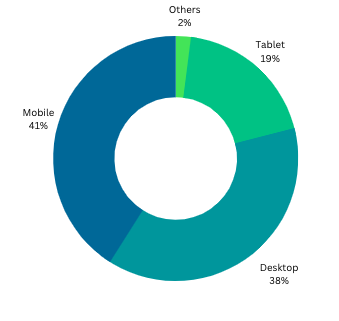
FAQs on Inbound Marketing
What are the Things to keep in mind when planning for inbound marketing?
These are the things you should look for when planning for inbound marketing:
- Problems people are looking to solve.
- Create content that is aligned with the solutions that people are looking for their problems.
- Use analytical tools to see the performance of the content.
- Analyse the content and the channels where it should perform for maximum output.
- Think to include paid advertising platforms like Google Ads.
- Evaluate the readers’ behaviour and then create content to keep them engaged.
What is Difference between Inbound Marketing and Content Marketing?
These are the difference between the two types of marketing:
| Inbound Marketing | Content Marketing |
|---|---|
| Inbound marketing is positioning yourself to be found when some audience is looking for you. | Content marketing is creating useful content that people are looking for. |
| Inbound marketing cannot be done without content marketing. | Content marketing can go without inbound marketing. |
| Inbound marketing involves attracting the target audience to your content. | Whereas content marketing can be without attracting the customers. You can use any of the techniques like posting content on social media, emails, live presentations, and webinars. |
What is Difference between Inbound Marketing and Outbound Marketing?
This is the difference between Inbound Marketing and Outbound Marketing:
| Inbound Marketing | Outbound Marketing |
|---|---|
| Inbound marketing involves informative digital content for a target audience and helps them to solve their problems. | Outbound marketing is created to capture the audience’s attention but it is not a digital content. |
| Content in the form of blogs, emails, reports, webinars. | Outbound marketing is for magazine ads, billboards, etc. |
| Messages can be tailored to specific target audiences. | Messages stand out among millions of other consumers each day. |
| Output can be measured through digital marketing software. | It is difficult to measure the attributes. |
Influencer Marketing
Definition
Influencer marketing is a marketing strategy that involves partnering with individuals with a large social media following and a significant influence over their audience.
Description
Influencers are typically experts or personalities in a particular niche or industry and can reach and engage with a specific target audience.
Influencer marketing aims to leverage the influencers’ credibility and relationship with their audience to promote a brand, product, or service and drive engagement, awareness, and sales.
This marketing can take many forms, including sponsored content, product reviews, affiliate marketing, and social media campaigns.
Influencer marketing is an effective way to reach and engage with a target audience, particularly among younger demographics who may be challenging to get through traditional advertising.
Importance of Influencer Marketing
Influencer marketing is essential for several reasons.
It helps businesses reach a highly targeted audience that may need help getting through traditional advertising methods.
Influencers have built up a loyal following of individuals who are interested in their content and trust their opinions, making them valuable partners for brands looking to promote their products or services.
Influencer marketing can help brands build trust and credibility with their audience. By partnering with respected and trusted influencers in their niche or industry, brands can leverage their authority to build credibility and trust with their target audience.
This marketing can be an effective way to generate brand awareness and drive sales.
Influencers can create authentic, engaging content that resonates with their audience, leading to increased visibility, engagement, and conversions for brands.
How to prepare strategy for influencer marketing?
Here are some steps to prepare the best strategy for this marketing:
- Define your goals: Determine what you want to achieve with your influencer marketing campaign, such as increasing brand awareness, driving sales, or building relationships with your target audience.
- Identify your target audience: Understand who your target audience is and what influencers they follow. This will help you identify the right influencers to partner with and create content that resonates with your audience.
- Research and select influencers: Use tools such as social media analytics, influencer directories, and audience demographics to identify and select the right influencers for your campaign.
- Develop a content plan: Work with your influencers to develop a content plan that aligns with your brand and messaging. This should include the type of content, posting schedule, and any guidelines or requirements.
- Set a budget: Determine how much you will spend on your influencer marketing campaign and allocate resources accordingly. This should include influencer fees, production costs, and additional expenses.
- Measure and track results: Use tools such as social media analytics and tracking codes to measure the success of your influencer marketing campaign. This will help you identify areas for improvement and refine your strategy for future campaigns.
Future of Influencer Marketing
The future of influencer marketing is promising as it continues to evolve and adapt to the changing landscape of digital marketing. Here are some trends and predictions for the future:
- Increased focus on authenticity and transparency: Consumers are becoming more savvy and discerning in influencer marketing and seek more authenticity and transparency from brands and influencers. As a result, there will likely be a greater emphasis on genuine and transparent partnerships between brands and influencers.
- Micro-influencers and niche audiences: As social media becomes more saturated with influencers, brands may turn to micro-influencers and influencers with more minor, niche audiences to reach specific target markets.
- Live streaming and video content: Live streaming and video content are becoming increasingly popular on social media. Influencers who can create engaging, authentic video content will be in high demand.
- Emerging platforms and technologies: New social media platforms and technologies, such as TikTok and augmented reality, will continue to shape the influencer marketing landscape and offer new opportunities for brands and influencers to connect with their audiences.
Benefits of Influencer Marketing
It is a marketing strategy that involves collaborating with individuals with a significant social media following to promote products or services. Here are some of the benefits of influencer marketing:
- Increased brand awareness: Working with influencers can help businesses reach a wider audience and increase their brand awareness. Influencers typically have a dedicated following that trusts their opinions and recommendations.
- Authenticity: Influencers can add realism to a brand’s messaging. When an influencer promotes a product or service, it can feel more genuine than a traditional advertisement.
- Targeted marketing: Influencers often have a specific niche or audience that they appeal to. By working with an influencer, businesses can target a particular group of consumers likely to be interested in their products or services.
- Improved engagement: Influencers can generate a high level of engagement with their audience. By promoting a brand’s products or services, influencers can encourage followers to engage with the brand and become customers.
- Cost-effective: Influencer marketing can be a cost-effective way to promote a brand. Working with influencers can be relatively affordable compared to traditional advertising methods, especially for small businesses.
- SEO benefits: Influencer marketing can also have SEO benefits. When an influencer mentions a brand on their social media platforms or blog, it can generate backlinks to its website, improving its search engine ranking.
Read More: Influencer Marketing The Ultimate Guide for 2024
Example
Nykaa has collaborated with several Indian social media influencers, particularly those in the beauty and fashion space, to promote their products.
For instance, the company worked with famous beauty influencer Shreya Jain, who has over 1 million followers on Instagram, to promote their range of lipsticks.

Nykaa also worked with celebrity influencer Katrina Kaif, who has over 50 million followers on Instagram, to promote their range of makeup products.
Kaif created a series of posts and videos showcasing the products and how to use them, which generated a lot of buzz and engagement among her followers.
Through these collaborations, Nykaa has reached a large and engaged audience, increased brand awareness, and generated sales.
This is just one example of how influencer marketing can be an effective tool for Indian brands to promote their products and reach their target audience.
FAQs
Why is influencer marketing important?
It can be an effective way for brands to reach and engage with a target audience, build brand awareness, and drive sales.
How do you choose the right influencers for your brand?
When selecting influencers, brands should consider factors such as the influencer’s audience demographics, engagement rates, and relevance to their brand and products.
How do you measure the success of influencer marketing?
Metrics such as engagement rates, impressions, and conversions can be used to measure the success of influencer marketing campaigns.
How much does influencer marketing cost?
The cost of this marketing can vary widely depending on factors such as the size and reach of the influencer’s audience, the type of content created, and the length of the campaign.
How can you ensure that influencer marketing campaigns comply with regulations?
Brands should ensure that this marketing campaigns comply with laws such as the FTC guidelines for sponsored content by clearly disclosing the nature of the partnership and the fact that the influencer is being compensated.
What are some common mistakes to avoid in influencer marketing?
Common errors in this include partnering with influencers who don’t align with your brand values, focusing too heavily on follower count rather than engagement, and failing to establish clear objectives and metrics for the campaign.
Information Architecture
Definition
Information architecture (IA) is the practice of organising, structuring, and labelling content (such as websites, applications, and documents) to make it easy for users to find and understand.
Description
A well-designed information architecture can make it easier for users to find and access the necessary information. By organising and logically structuring content, information architecture can increase the usability of a product.
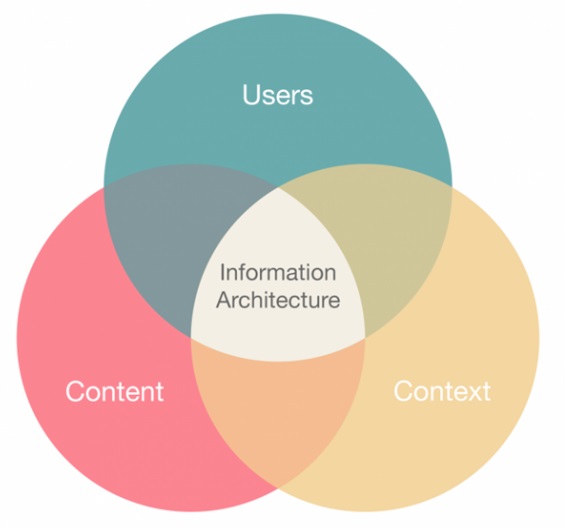
Well crafted information architecture can support scalability as digital products and services grow and evolve.
Information architecture involves designing and organising information, including creating navigation structures, taxonomies, and search systems that allow users to access and interact with content efficiently and effectively.
It is a critical aspect of user experience design, as it can significantly impact how users perceive and engage with digital products and services.
Importance of Information Architecture
Information architecture (IA) is essential for several reasons:
- User Experience: A well-designed IA can make it easier for users to find and access the necessary information. This can lead to a better user experience, as users are less likely to become frustrated or confused when trying to navigate a website or application.
- Usability: By organising and logically structuring content, IA can increase the usability of a product. Users can quickly and easily find what they are looking for, reducing the time and effort required to complete tasks.
- Findability: IA can help users find information quickly and efficiently, even if they need to know exactly what they want. This is achieved through clear labelling, intuitive navigation, and practical search functionality.
- Scalability: A well-designed IA can support scalability as digital products and services grow and evolve. It can provide a framework that quickly and effectively accommodates new content, features, and functionality.
- Consistency: IA can help ensure consistency across a product or service, making it easier for users to understand and use different system parts. This helps build trust and confidence in the product or service.
- Efficiency: A well-designed IA can help users complete tasks more quickly and efficiently, reducing frustration and increasing productivity.
How to make information architecture?
A good information architecture requires a structured process and careful consideration of user needs, business goals, and technical constraints. Here are some steps to follow when creating an information architecture:
- Identify User Needs: Conduct user research to understand the needs and goals of your target audience. This can involve user interviews, surveys, and usability testing to better understand user behaviour.
- Define the Scope: Identify the content, features, and functionality included in the information architecture. This can involve creating a content inventory and auditing existing content to determine what needs to be included.
- Create User Personas: Develop user personas that represent your target audience. This can help you understand their goals, needs, and behaviours and create an information architecture that meets them.
- Develop a Site Map: Create a site map that outlines the structure of the website or application, including the primary navigation and sub-navigation. This can help you visualise the organisation of content and ensure that it is logical and intuitive for users.
- Create Wireframes: Develop wireframes that show the layout and structure of content on each page or screen of the website or application. This can help refine the information architecture and ensure it meets user needs.
- Test and Refine: Conduct usability testing to evaluate the information architecture and identify areas for improvement. Refine the information architecture based on user feedback and testing results.
- Document and Maintain: Document the information architecture and maintain it over time. This can involve creating guidelines and standards for content creation and organisation and regularly reviewing and updating the information architecture to ensure it remains relevant and practical.
The Future of Information Architecture
The field of information architecture (IA) is constantly evolving and changing in response to new technologies and user needs. Here are some trends that are likely to shape the future of IA:
- Emphasis on Accessibility: As more users with disabilities use digital products and services, IA will need to focus more on accessibility. This includes designing products usable by people with different abilities, such as those who are blind or have limited mobility.
- Use of AI and Machine Learning: IA will increasingly incorporate artificial intelligence (AI) and machine learning (ML) to help users find and access information more efficiently. This can include personalised recommendations, predictive search, and natural language processing.
- Integration with Voice Interfaces: As voice interfaces become more popular, IA will need to adapt to the unique needs of this interface. This includes designing navigation and content that can be accessed through voice commands and ensuring that content is optimised for voice search.
- Focus on Ethical Design: IA will increasingly need to address ethical considerations, such as privacy, security, and transparency. This includes designing products that protect user data and respect user privacy, and being transparent about how data is collected and used.
- Integration with the Internet of Things: IA must adapt to the growing number of devices connected to the Internet of Things (IoT). This includes designing products that can be accessed and controlled through various devices and ensuring that content is optimised for different screen sizes and resolutions.
Benefits of Information Architecture
Information architecture (IA) provides several benefits for digital products and services. Here are some of the critical benefits of IA:
- Improves User Experience: IA helps users find and access the information they need quickly and efficiently. This can lead to a better user experience, as users are less likely to become frustrated or confused when navigating a website or application.
- Enhances Usability: By organising and logically structuring content, IA can increase the usability of a product. Users can quickly and easily find what they are looking for, reducing the time and effort required to complete tasks.
- Increases Findability: IA can help users find information quickly and efficiently, even if they don’t know precisely what they want. This is achieved through clear labelling, intuitive navigation, and practical search functionality.
- Enables Scalability: A well-designed IA can support scalability as digital products and services grow and evolve. It can provide a framework that can accommodate new content, features, and functionality without becoming overly complex or difficult to use.
- Ensures Consistency: IA can help ensure consistency across a product or service, making it easier for users to understand and use different system parts. This helps build trust and confidence in the product or service.
- Improves Efficiency: A well-designed IA can help users complete tasks more quickly and efficiently, reducing frustration and increasing productivity.
Example
Here is an example of information architecture for a simple e-commerce website:
A) Home Page:
- Navigation bar: Home, Shop, About Us, Contact Us
- Hero banner: Promoting a new collection
- Featured products: Displaying top-selling products
B) Shop Page:
- Navigation bar: Categories, Price range, Brand
- Product listings: Showing product name, image, price, and rating
- Sorting and filtering options: Sort by price, popularity, and relevance, and filter by category and Brand
C) Product Detail Page:
- Product image
- Product title, price, and description
- Customer reviews and ratings
- Add to cart button
D) Cart Page:
- List of products in the cart
- Quantity adjustment and delete option for each product
- The total price of the cart
- Checkout button
E) Checkout Page:
- Billing and shipping address
- Payment options: Credit card, PayPal
- Order summary
- Place order button
FAQ
What is information architecture?
Information architecture (IA) is the process of organising and structuring content, data, and functionality in an intuitive and easy way for users.
Why is information architecture important?
IA is important because it helps to improve the usability, findability, and overall user experience of digital products and services. It ensures that users can find and access the information they need quickly and efficiently, leading to a positive user experience.
What are some fundamental principles of information architecture?
Some key principles of IA include organisation, labelling, navigation, search functionality, and consistency. These principles help to create a coherent and user-friendly system for users to interact with.
What are some tools or techniques used in information architecture?
Some standard tools and techniques used in IA include site maps, wireframes, card sorting, user research, and usability testing.
These tools and techniques help IA professionals to design and test effective information architectures.
What are some expected IA deliverables?
Common IA deliverables include site maps, wireframes, content inventories, and taxonomies. These deliverables provide a clear and visual representation of the information architecture and help guide the design and development process.
How does information architecture relate to user experience (UX) design?
IA is a critical component of UX design, as it helps to ensure that the digital product or service is organised and structured in a way that is easy to use and provides a positive user experience. UX designers use IA principles and techniques to create effective and user-friendly systems.
How does information architecture impact SEO?
IA can impact SEO by ensuring that content is organised and structured in a search engine-friendly way. A well-designed IA can also improve user engagement and reduce bounce rates, which can impact search engine rankings.
Lead Generation
Definition
Lead generation identifies and cultivates potential customers or clients for a business’s products or services.
Description
Lead generation is a crucial aspect of marketing and sales for businesses of all sizes.
By identifying and cultivating potential customers, businesses can expand their customer base, increase revenue, and improve overall business performance.
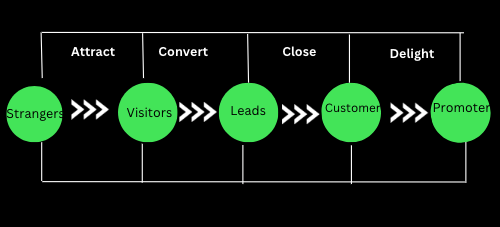
In addition, lead-generation strategies can help companies attract and convert leads into paying customers, ultimately driving business growth.
The process of lead generation involves attracting potential customers through various marketing channels, such as social media, email marketing, content marketing, and advertising.
Once leads are generated, businesses use multiple tactics to nurture and convert them into paying customers, such as targeted email campaigns, personalised content, and follow-up calls or messages.
Importance of lead generation
Lead generation is critical for the success of a business for several reasons:
- Increased revenue: By generating more leads, a business can increase its chances of converting those leads into paying customers, ultimately leading to increased revenue.
- Cost-effective: Compared to traditional advertising methods, lead generation can be a cost-effective way for businesses to attract potential customers and drive sales.
- Targeted marketing: Lead generation allows businesses to target their marketing efforts to individuals who are already interested in their products or services, making it more likely that they will convert into paying customers.
- Improved customer relationships: By engaging with potential customers early in the buying process, businesses can build relationships and establish trust, leading to long-term customer loyalty.
- Measurable results: Lead generation allows businesses to track and measure the success of their marketing efforts, allowing them to optimise their approach over time and achieve better results.
How to create a successful lead generation process?
Creating a successful lead-generation process involves several key steps:
- Define your target audience: Identify the characteristics of your ideal customer, including demographics, interests, and pain points. This will help you tailor your marketing efforts to attract the right leads.
- Develop a compelling offer: Create a valuable offer that will motivate potential customers to engage with your business. This could be a free trial, discount, or gated content like an ebook or whitepaper.
- Choose the proper channels: Determine which marketing channels are most effective for reaching your target audience. This could include social media, email marketing, content marketing, or paid advertising.
- Optimise your website: Ensure it is optimised for lead generation, with clear calls-to-action, landing pages, and forms that make it easy for visitors to provide their contact information.
- Nurture leads: Once you’ve generated leads, use targeted and personalised communication to nurture them and move them through the sales funnel. This could include email campaigns, retargeting ads, or one-on-one sales outreach.
- Analyse and adjust: Continuously analyse your lead generation efforts to identify areas for improvement. Use data to change your approach and optimise your process over time.
Future of Lead Generation
The future of lead generation will likely involve a continued focus on using data and technology to improve the process. Here are some potential strategies that businesses may use in the future:
- AI-powered lead generation: Artificial intelligence (AI) can analyse large amounts of data and identify patterns and insights that inform lead generation strategies.
- Personalised marketing: Businesses may increasingly use data and automation tools to create customised marketing experiences that speak directly to the needs and preferences of individual leads.
- Chatbots and messaging apps: Chatbots and messaging apps can provide a convenient and immediate way for leads to engage with a business and get the information they need.
- Interactive content: Interactive content, such as quizzes, calculators, and surveys, can provide a more engaging and interactive experience for leads, leading to higher engagement and conversion rates.
- Social media lead generation: Social media platforms will likely play a key role in lead generation. Businesses use paid advertising and influencer marketing to reach and engage potential customers.
Example
HubSpot is a marketing and sales software company. HubSpot offers a range of free resources, such as marketing templates and educational content, designed to attract potential customers and generate leads.
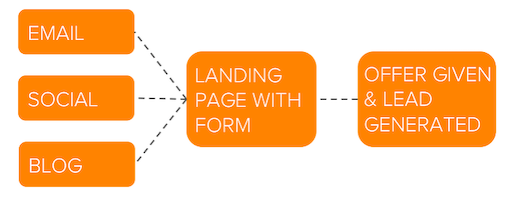
These resources are gated, meaning visitors must provide their contact information. HubSpot then uses this information to nurture leads and guide them through the sales funnel.
This approach has been highly successful for the company, helping it generate a large and engaged customer base while providing value to its target audience.
FAQs
Why is lead generation important?
Lead generation is critical for businesses looking to attract and convert potential customers into paying customers. With a steady stream of leads, companies may be able to generate revenue and grow their customer base.
How do you generate leads?
There are many ways to generate leads, including content marketing, social media advertising, search engine optimization (SEO), and email marketing.
How do you measure the success of lead generation?
Metrics such as lead conversion rates, cost per lead, and overall return on investment (ROI) can be used to measure the success of lead generation efforts.
What are some common mistakes to avoid in lead generation?
Common mistakes in lead generation include failing to target the right audience, offering low-quality content or incentives, and neglecting to follow up with leads in a timely manner.
What are some best practices for lead generation?
Best practices for lead generation include creating high-quality, targeted content, optimising landing pages for conversion, and using marketing automation tools to nurture leads and guide them through the sales funnel.
How can you optimise your lead generation process over time?
By tracking and analysing key metrics and experimenting with different approaches, businesses can continuously optimise their lead-generation process to achieve better results.



